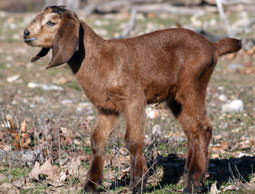
 Photo by Sue Weaver Mom got her bottle baby! Here’s Milo. He has a milk moustache. |
Last week and the week before, I talked about some of the things Uzzi and I learned about raising bottle-baby lambs and kids. We hope this three-part series helps if you become Mom or Dad to a newborn kid or lamb.
Last week, we told you what to feed a lamb or kid; this week we’ll show you how to feed them with a bottle. Start by getting a nipple your tiny baby will probably like. Mom uses a funny-looking thing called a Pritchard teat that screws onto empty soda-pop and water bottles. Another good choice is a human-infant bottle and nipple. Avoid hard, black, rubber “lamb nipples” from the feed store. Lusty feeders yank them off and make a mess.
Mom uses a feeding schedule designed by Lyn Brown, a nice lady who raises California Red sheep. Amounts are for a typical medium-sized breed lamb or kid; feed less to small breeds, like Shetland lambs and Pygmy kids, and more to bigger ones, like Boer kids and Romney lambs. Here’s the program in Lyn’s own words. (If you’re feeding a baby goat, substitute “lamb” with “kid”). Print it out and save it. You won’t go wrong with this method!
“To start my new lambs, I sit with my legs crossed and the lamb tucked in the middle in a sitting position (front legs straight and butt on ground). I cup my left hand under the lamb’s jaw, open its mouth and insert the nipple with the right hand. Once the nipple is in the mouth, I balance and steady the nipple with the left hand that is still under the jaw.
“I keep the bottle and nose aligned so the lamb doesn’t spit out the nipple or move it to the side or back of its mouth. I elevate the bottle with my right hand only enough to avoid the lamb sucking air. In this position, you can feel the lamb’s throat with the heel of your hand and you know if it is swallowing.
“If you elevate the bottle too much, milk can pour into the mouth, and if the lamb isn’t swallowing, the milk can enter the lungs. I keep the bottle as level as possible while keeping milk in the bottle cap and nipple. That means the more the bottle empties, the more tilt there needs to be.
“Many people kill their first bottle baby with kindness; they overfeed it because the lamb cries and they think it must be hungry. I know I did. I follow this feeding schedule strictly (no exceptions). If lambs cry between feeds, we feed them Pedialyte or Gatorade. That won’t hurt them as far as enterotoxemia goes, and it gives them electrolytes while filling the void for them.
Feeding Schedule:
- Days 1 to 2: 2 to 3 ounces, 6 times per day (colostrum or formula with colostrum replacer powder)
- Days 3 to 4: 3 to 5 ounces, 6 times per day (gradually changing to whole sheep, cow or goat milk or lamb milk replacer)
- Days 5 to 14: 4 to 6 ounces, 4 times per day
- Days 15 to 21: 6 to 8 ounces, 4 times per day
- Days 22 to 35: work up gradually to 16 ounces, 3 times per day
“At about 6 weeks, I begin slowly decreasing the morning and evening feedings and leave the middle feeding at 16 ounces, until I eliminate the morning and evening bottle entirely. (They are eating their share of hay [LINK: /crops-and-gardening/hay-feeding-14792.aspx] or pasture [LINK: /crops-and-gardening/grasses-pasture-plants-25470.aspx] by now.) I continue with one 16-ounce bottle for about two weeks, then eliminate the bottle feedings entirely.
“By making changes gradually, you can observe changes in the condition of the lamb and judge and adjust accordingly. Gradual changes also avoid the complications of sudden changes in diet, some of which can be fatal. Whatever you do, when you buy milk replacer, use lamb replacer. All-purpose milk replacers and calf replacers do not work well with lambs.”
« More Mondays with Martok »




